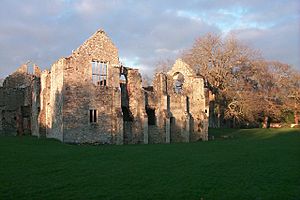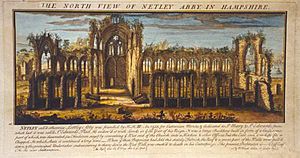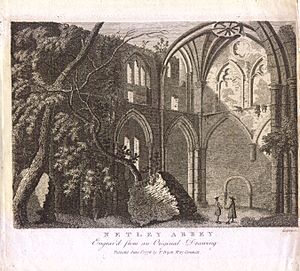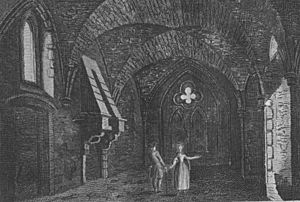Netley Abbey facts for kids
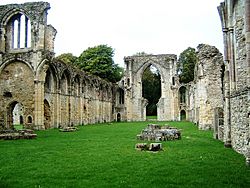
Ruins of the church at Netley Abbey
|
|
| Monastery information | |
|---|---|
| Full name | The Abbey Church of St Mary of Edwardstow (Sanctae Mariae de Loco Sancti Edwardi) |
| Other names | Latin: Laetus Locus (Happy Place), Lieu-Saint-Edward, Letley |
| Order | Cistercians |
| Established | 1239 |
| Disestablished | 1536/7 |
| Mother house | Beaulieu Abbey |
| Dedicated to | Virgin Mary and Edward the Confessor |
| Diocese | Diocese of Winchester |
| People | |
| Founder(s) | Peter des Roches and Henry III |
| Important associated figures | William Paulet, Abbot Thomas Stevens |
| Site | |
| Location | Netley, Hampshire, United Kingdom |
| Visible remains | major ruins of church, monastic buildings and post-Dissolution mansion |
| Public access | open to the public (English Heritage) |
Netley Abbey is a beautiful ruined monastery in the village of Netley, near Southampton in Hampshire, England. It was built a very long time ago, in the Late Middle Ages, specifically in 1239. This abbey was home to a group of Cistercian monks. They were known for living a simple life.
Even though kings helped them, Netley Abbey was never super rich. The monks didn't become famous scholars or church leaders. Their nearly 300-year history was mostly peaceful. People living nearby knew the monks best for being very kind. They offered a warm welcome to anyone traveling by land or sea.
In 1536, King Henry VIII took over Netley Abbey. This happened during a time called the Dissolution of the Monasteries. The king gave the abbey buildings to William Paulet, a powerful politician. He changed the abbey into a grand house. It was used as a country house until the early 1700s. After that, it was left empty and parts were pulled down for building materials.
Later, the ruins became a popular place for visitors. They even inspired poets and artists from the Romantic movement. In the early 1900s, the abbey was given to the nation. Now, English Heritage looks after it. Netley Abbey is one of the best-preserved medieval Cistercian monasteries in southern England. You can still see the church, the buildings where the monks lived, the abbot's house, and parts of the old mansion.
Contents
How Netley Abbey Started
Netley Abbey was first thought of by Peter des Roches. He was a very important bishop in Winchester. He died in 1238, and the abbey was founded shortly after, in 1239. The original name for the abbey was "the church of St Mary of Edwardstow." The name Netley probably comes from an older name, "Letley."
Bishop des Roches wanted to build two monasteries to remember himself. Netley was one of them. He started buying land for Netley around 1236. But he passed away before it was finished. So, his helpers completed the project. The first monks arrived on July 25, 1239. They came from a nearby abbey called Beaulieu Abbey.
Because its founder died early, the abbey had money problems at first. But then, Henry III became interested in it around the 1240s. He officially became the abbey's supporter in 1251. This royal help allowed the building work to really begin.
The Abbey Buildings
The Church
The king's support helped build a huge church. It was about 72 meters (236 feet) long. The church was built in a popular style called Gothic architecture. This style was also used at Westminster Abbey. The church had fancy decorations and designs. This showed how royal support changed Cistercian churches. They became grander, like big cathedrals.
Workers built the church from east to west. The sanctuary (the eastern part) and transepts (the arms of the cross shape) were built first. This allowed the monks to hold services. The nave (the main body of the church) was finished later. We don't know exactly when building started. But King Henry gave gifts of wood and lead in 1251 and 1252. This means parts of the church were already well underway.
A special stone at the church's center says "Henry by the Grace of God King of the English." This shows that the church's foundations reached ground level after 1251. That was the year Henry III became the abbey's official patron. The church took many decades to build. It was probably finished between 1290 and 1320.
The church was shaped like a cross. It had a square sanctuary and a low central tower with bells. It had aisles all around. There were two chapels on the east side of each transept. A narrow gallery with lancet windows ran above the main arches. You can still see this in the south transept.
The east wall of the sanctuary had a large window. It featured a rose shape and fancy designs. The aisle windows were simpler. The south aisle of the nave had plain windows. The north aisle windows were more decorated. This shows that the north aisle was one of the last parts built. The west wall also had a large window. Its design suggests it was built around the year 1300.
Inside, the church had different areas. The main altar was at the east end. The monks sat in choir stalls under the tower for services. A screen separated these areas from the rest of the church. Lay brothers (monks who did manual labor) had their own stalls and altar in the nave.
Monks at Netley prayed and held services day and night. A staircase in the south transept led to the monks' sleeping area. This made it easy for them to attend night services. The lay brothers had their own entrance to the church.
Cistercian monks usually kept their churches just for the monks. Other people had to worship in a separate chapel near the abbey gate. But over time, this rule became more relaxed. People could visit shrines or build tombs inside. Digs have found pieces of fancy tombs and monuments at Netley.
The church's inside was very colorful. The walls were painted white and maroon. They had patterns that looked like stone blocks. The floors were covered with colorful encaustic tiles. These tiles showed plants, animals, and coats of arms. Some showed the symbols of England, France, and royal families. Windows had painted glass. Six pieces have been found. They show scenes from the life of the Virgin Mary, the Crucifixion, monks, and funny animals.
Cloister and East Building
South of the church is the cloister. It's a square courtyard surrounded by buildings. The church forms one side. The cloister was the heart of the abbey. Monks spent most of their time here when not in church. They studied, copied books, and created beautiful illuminated manuscripts. Monks' desks were in the north part of the cloister. A cupboard for books was in the wall of the south transept.
The east building started at the same time as the church. It probably took about 10 years to build. It held many important rooms. The library and sacristy (where church items were kept) were on the ground floor, next to the church. South of this was the chapter house. Here, monks met daily to discuss abbey business and listen to readings.
At Netley, the chapter house was a grand room. It had three aisles and vaults supported by four columns. A stone bench ran along the walls for the monks. The abbot's (the head monk's) seat was in the middle of the east wall. The entrance from the cloister was a fancy arched doorway. It had windows on each side. These windows likely had no glass. This allowed lay brothers to listen to the meetings. The chapter house was also a burial place for abbots. When the room was dug up, archaeologists found human remains.
South of the chapter house was the parlour. This was a simple, barrel-vaulted room. Monks could talk here without breaking the silence in the cloister. Cistercian rules were strict about silence. South of the parlour was a long hall. This room changed over time. It might have been the monks' day room or for new monks. Later, it might have become the misericord. This was a place where monks could eat meat. Meat was usually not allowed in the main dining hall.
The monks' dormitory (sleeping area) was on the top floor of the east building. It was a long room with a high roof. You can still see where the roof joined the church wall. Monks entered it by two staircases. The day stair went down to the cloister. The night stair led into the church. This made it easy for monks to go from bed to church for night services. At first, the dormitory was one open room. Beds were along the walls. Later, it was divided into private sections with wooden walls. Each monk had his own space. A small, vaulted room called the treasury was at the north end of the dormitory. It was probably placed there for safety at night.
Reredorter and Infirmary
Another large building stands at the south end of the east building. Its lower level has a vaulted hall with a large fireplace. It also had its own garderobe (toilet). We are not sure what this room was used for. It might have been the monastic infirmary (sick room). If so, it was very unusual. Usually, an infirmary would be a separate building with its own kitchen and chapel. But at Netley, these seem to be missing. Digs have not yet found a separate infirmary complex.
The upper floor of this building was the reredorter, or latrine (communal toilet). It was a large room with a door leading from the monks' dormitory. The toilet stalls were in the south wall. Waste dropped into an underground stream that flowed beneath the building.
West of the reredorter was the buttery. This room stored the monks' wine and beer. Some wine came directly from the king's cellars. Digs in this area have found small remains. These might be from a separate kitchen. This kitchen would have prepared richer food for sick monks.
South Building
The south building was greatly changed when the abbey became a private house. Only the north wall of the medieval structure remains. This makes it hard to know its original layout. From east to west, first came the day stair. Then there was the warming house. A fire burned constantly here. Monks could warm themselves after studying in the cold cloister. This room likely had a large fireplace. The room above the warming house was probably the muniment room. Here, the abbey's important papers and records were kept.
The refectory (dining hall) stuck out south from the middle of the building. This was common in Cistercian monasteries. Most of it is now gone, but its foundations are still underground. It was a long hall. The abbot and important guests sat at the south end. A pulpit in the west wall allowed a monk to read during meals. The kitchen was to the west. It had a central fireplace, as was Cistercian custom. Food could be served through openings to both the monks' refectory and the lay brothers' dining hall.
West Building
The west building at Netley is small. It doesn't run the full length of the cloister's west side. It is split in two by the abbey's main entrance. There was an outer parlour where monks could meet visitors. North of this were cellars for food storage. To the south was the lay brothers' refectory. The upper floor was the dormitory for the lay brothers. It was reached by a stair from the cloister.
Netley was built later than many abbeys. By this time, the number of lay brothers was decreasing. So, less space was needed for them. By the 1300s, they were almost gone. Many abbeys used the empty lay brothers' quarters for new purposes. Some built comfortable rooms for abbey officials or guests. Others turned the area into a fancy home for the abbot. The ruins of Netley's west building are too broken to know its later use.
All the buildings around the cloister were finished by the 1300s. There were few big changes after that, except for re-vaulting the church's south transept in the late 1400s. However, there were likely many small changes inside. These would have made the abbey more comfortable as living standards improved.
Abbey Grounds
A stone building east of the main abbey is thought to be the abbot's house. It has two levels of vaulted rooms. These include two halls, bedrooms, a private chapel, and service rooms. The upper level had an outside staircase. This allowed it to be used separately if needed.
The main part of the monastery was surrounded by a large area called the precinct. This area had public and private courtyards, gardens, barns, guesthouses for travelers, stables, and fishponds. It also had the abbey's farm and workshops. A high bank and moat protected the site. Parts of the moat are still visible east of the abbey. Entry was controlled by outer and inner gatehouses. A chapel, called the "chapel outside the gates," was near the outer gatehouse. It was for travelers and local people to use. Of all these buildings, only the abbot's house, the moat, and the fishponds can still be seen.
Netley got its fresh water from two aqueducts. These ran for several miles east and west of the abbey. Remains of the eastern aqueduct can still be seen today.
Monastic Life and Challenges
King Henry III gave Netley Abbey more land and property. By 1291, the abbey had a good income of £81 per year. However, soon after, the abbey faced money problems. It almost went bankrupt. In 1328, the government had to send an administrator to help. He made the abbot pay back debts and sell some lands. But this only partly worked.
Ten years later, the abbey again asked the king for help. They said their problems were due to the cost of hosting many travelers and sailors. The king gave them some small grants. This helped the abbey get through its difficulties. But because they had sold land, the abbey's income never fully recovered. It became what people called "genteel poverty."
Despite this, Netley remained a respected place. It wasn't famous for learning or great wealth. But it was highly regarded for being generous to travelers and sailors. People also respected the monks for their devout lives. The abbot was often asked to attend Parliament meetings. Reports suggest the abbey had a peaceful life with no major scandals.
A Book from Netley Abbey
Most medieval monasteries had many books. These included religious texts, spiritual works, and books on practical subjects. Monks needed texts for their daily services and prayers.
Today, only one book is known to have belonged to Netley Abbey. It is kept in the British Library in London. The book has a note from the 1400s that says, "This book belongs to the house of Saint Mary of Netteley." The book itself is a Latin manuscript from the 1200s. It is a copy of Chronicles by Roger of Hoveden. Roger was an English historian who wrote about the reigns of King Henry II and King Richard I. He was also a priest and traveled with Richard I on the Third Crusade.
The Abbey Closes Down
In 1535, King Henry VIII ordered a survey of all church finances. This was before he began taking over the monasteries. Netley Abbey's income was recorded as £160 gross, or £100 after expenses. This meant it was included in the First Suppression Act the next year. This was Henry's first step in the Dissolution of the Monasteries.
In early 1536, royal officials visited Netley. They reported that the abbey had seven monks, all priests. They noted that Netley was:
A main house of Cistercian Monks, being a large building and located by the sea. It gives great help and comfort to the King's subjects and strangers traveling by sea.
Besides the monks, Netley had 29 servants and officials. There were also two Franciscan friars staying there. They had been placed in the abbot's care by the king. This was likely because they disagreed with his religious policies. The officials also found valuable items like silver and jewels worth £43. They found other church items worth £39. And they found farm produce and animals worth £103. The abbey's debts were not too high, at £42.
Abbot Thomas Stevens and his seven monks had to give up their abbey to the king in the summer of 1536. Abbot Thomas and six monks went to their mother house, Beaulieu Abbey. The seventh monk chose to become a regular priest. Abbot Stevens became the Abbot of Beaulieu in 1536. He led it for two years until Beaulieu also had to surrender to the king in 1538. The monks received pensions after Beaulieu closed. Abbot Thomas later became the treasurer of Salisbury Cathedral and died in 1550.
From Abbey to Country House
After Netley Abbey was closed, King Henry gave the buildings to Sir William Paulet. He was the king's Lord Treasurer. Sir William immediately began turning the abbey into a grand home. It was fit for one of England's most important politicians.
He changed the church's nave into his great hall, kitchens, and service rooms. The transepts became fancy apartments for his personal use. The presbytery (the eastern part of the church) became the mansion's chapel. The monks' dormitory became a long gallery in the mansion. The old latrine block became several large rooms.
He pulled down the south building and the refectory. He built a new one with a central tower and gatehouse. This made the house look like a classic Tudor courtyard home. He also removed the cloister walks. This created a central courtyard for his house with a large fountain. The other abbey buildings were pulled down to make formal gardens.
Later, the abbey was sold several times. Theophilus Hastings, 7th Earl of Huntingdon, lived there until the late 1600s.
A Romantic Ruin
Around 1700, Netley Abbey belonged to Sir Berkeley Lucy. In 1704, he decided to pull down the house. It was no longer fashionable, and he wanted to sell the materials. Sir Berkeley made a deal with a builder named Mr. Walter Taylor. Taylor was supposed to take down the old church. However, during the demolition, a stone fell from a window and killed him. The work stopped after that.
The abbey was then left to decay. It became overgrown with trees and ivy. In the 1760s, Thomas Dummer moved the north transept of the church. He took it to his estate at Cranbury Park near Winchester. You can still see it there today as a folly (a decorative building) in the gardens.
By the late 1700s, the abbey had become a famous ruin. It attracted artists, writers, and poets. In the 1800s, Netley was a popular tourist spot. Even the novelist Jane Austen visited. People started to take steps to protect the ruins. Digs took place in 1860. During this time, owners removed many Tudor additions. They wanted the site to look more medieval. This meant some evidence of the abbey's later history was lost.
In 1922, the abbey was given to the state. The owner at the time was Tankerville Chamberlayne. Now, English Heritage continues to care for and study the abbey. Netley is a Scheduled Ancient Monument, which means it is protected by law.
Netley Abbey in Stories and Art
Soon after the abbey became a ruin, artists and writers became interested in it. It was a popular subject in the 1700s and 1800s. In 1755, Horace Walpole visited and called the ruins "not the ruins of Netley, but of Paradise."
In 1764, George Keate wrote a poem called The Ruins of Netley Abbey. It showed how beautiful the ruins were. It also made people feel sympathy for the monks who once lived there. Keate asked for the ruins to be preserved.
Other poets followed, like William Sotheby. His poem Ode, Netley Abbey, Midnight (1790) described the abbey as a gothic place. He imagined ghostly monks walking through the ruins. In 1795, Richard Warner wrote a scary story called Netley Abbey, a Gothic Story. It was about bad deeds happening at the abbey in the Middle Ages.
Dark stories also appeared in Richard Harris Barham's Ingoldsby Legends. This book made fun of the medieval church and the monks. It accused them of walling up a nun in a vault. But it also showed how beautiful the ruins were.
Netley Abbey, an Operatic Farce, a play by William Pearce, was first performed in 1794. The stage set for the play showed a detailed model of the abbey ruins in moonlight.
The oldest picture of the abbey was made by Samuel and Nathaniel Buck in 1733. It shows the church much as it is today. But it also shows the high vault of the south transept, which has since fallen. The most famous artist to paint the ruins was John Constable. His 1833 painting shows the west end of the church surrounded by trees.
Netley Abbey Today
Current Condition
Today, visitors can see the shell of the church and the monastic buildings around the cloister. The abbot's house is also there. Not much is left of the mansion built after the abbey closed. You can see some foundations and changes made with red Tudor brick. There are also traces of the formal gardens.
In most places, the abbey walls still stand almost at their original height. The sacristy/library, south transept chapels, treasury, reredorter undercroft, and the lower floor of the abbot's house still have their vaulted ceilings. You can see medieval heraldic tiles in the sacristy. King Henry III's foundation stone is still in the church.
The abbey ruins are in a wooded park. They are west of the village of Netley. It is the most complete Cistercian monastery ruin in southern England. English Heritage looks after the site. It is open for everyone to visit. Netley is an Ancient Monument, meaning it is protected by law.
Events and Closure
During summer, the abbey sometimes hosts events. These include open-air theatre shows. A flashmob wedding even took place there on June 25, 2011.
Netley Abbey was closed to the public in June 2018. This was due to safety concerns. Scaffolding used for conservation work was not up to standard. English Heritage decided to close it until it was safe again.
Local Stories
Over the years, several stories have grown up around the abbey.
Walter Taylor's Warning
One well-known story is about Walter Taylor. He was the builder hired to pull down the church. Legend says he had a dream before starting work. In the dream, he was warned that he would be hurt if he damaged the building. The story was told by an old writer named Browne Walters:
The earl (it is said) made a contract with a Mr. Walter Taylor, a builder of Southampton, for the complete demolition of the Abbey... After making this agreement, however, Taylor dreamed that, as he was pulling down a particular window, one of the stones forming the arch fell upon him, and killed him. His dream impressed him so strongly that he mentioned it to a friend... Taylor, however, at last decided to ignore his dream... he had not proceeded far, when, as he was assisting at the work, the arch of one of the windows, but not the one he had dreamed of (which was the east window still standing), fell upon his head and fractured his skull. It was thought at first that the wound would not be deadly; but it got worse, and the man died.
Blind Peter and the Treasure
Another local story says that during the Dissolution, the abbey's treasure was hidden. It was supposedly in a secret tunnel. A lone monk guarded it. Many years later, a treasure hunter named Slown found an underground passage. He went in but came out screaming, "In the name of God, block it up!" Then he dropped dead.
The Walled-Up Nun
The story of a nun being walled up in a small room is from Richard Barham's The Ingoldsby Legends. This story was made up by the author. It is not a real old folk tale. The author himself joked about it in his notes. He said he heard it from a cab driver who heard it from his grandmother.
See also
 In Spanish: Abadía de Netley para niños
In Spanish: Abadía de Netley para niños
|




